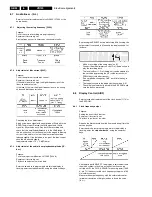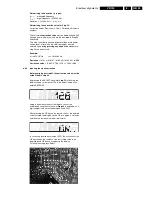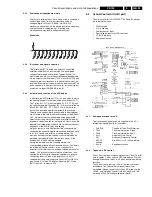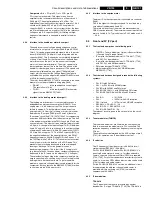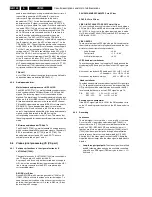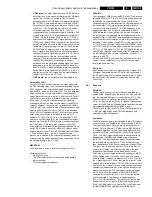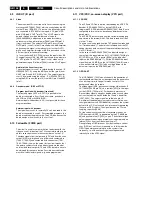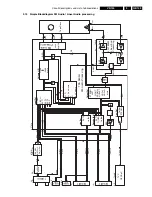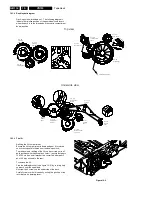
Circuit descriptions and List of abbreviations
GB 106
VR120
9.
9.9
IN/OUT (IO part)
9.9.1
Video
The entire video-I/O is carried out in 2-scart units using the
matrix switch STV6401 [7904), which is controlled by the AIO
via the IIC bus (SDA,SCL). To do this, the following signals
are connected to STV6401 at the inputs: VFV-pin4, VIN1-
pin6, VIN2-pin8, VOUT
1)
-pin10 (
1)
The VOUT signal is also
passed through a voltage divider and a low pass
[2906,3934,3928] and passed to the modulator where
necessary via the emitter follower [7909]) and VFR-pin12
(front cinch input). The outputs OUT3/pin15 (scart 2) and
OUT2/pin16 (scart 1) in the IC are fitted with a 6dB amplifier
and convey the signal to the relevant scart socket. OUT1/
pin2 has no amplifier; this signal (VBS) is passed on to the
VS circuit parts for further processing:
In 1-scart units the SE IC [7004] selects the input video. SE
IC original layout: VIN1 (the VBS line is used in the plan) pin
38 , VFV pin 36. The VOUT1 signal (scart 1 video out) is
generated using an E-follower [7908] from the VOUT signal.
Audio for the 2-scart version:
The output signal for scart 1 is selected using the switch - IC
HEF4053 [7911-C] using the MON control line (pin 9) from
AMLP (pin 5) and AINF_AIN2 (pin 3). The output signal for
scart 2 is selected using the switch - IC HEF4053 [7911-B]
using the DEC control line (pin 10) from AIN1 (pin 2) and AFV
(pin 1).
9.9.2
Decoder mode: (REC or STOP)
Program position with decoder (front end)
The front end signal (VFV or AFV1/2) is passed to the
decoder connected to Scart 2 and from there, goes back to
the VCR via VIN2 or AIN2L/AIN2R .
External input with decoder (9.2.2) is not possible for these
program positions.
External input with decoder
The signal from scart 1-in (normally TV set) is passed to the
decoder connected to scart 2. For scrambled programs, the
decoder switches the pin 8 to high. The VCR then passes the
decoded signal from scart 2-in to scart 1-out.
9.10 Follow Me (FOME part)
This circuit is used to compare the front end video with the
video on scart 1 (video from the TV connected) in order to be
able to save the stations in the same order as on the TV.
The video signals from the front end (VFV) and from the scart
socket (VIN1) are “digitised” using filters and comparators
[7530-C, 7530-D] and compared with one another [7531,
7532, 7530-A]. Low on the output for the circuit means that
the picture contents for the two video signals are identical
and that both receiver parts (TV and VCR) therefore have to
be adjusted for the same station. Possible errors detected
may result with similar signals, e.g. news programmes.
9.11 VPS/PDC, on-screen display (VPO part)
9.11.1 VPS/PDC
The VPS and PDC data is either decoded by the VPS-PDC
decoder-IC SDA5650 [7502] or by the OSD-IC with
integrated VPS, PDC decoder SDA5652 [7502]. Both ICs are
compatible in terms of pins, despite any differences in the
peripherals.
The VPS-PDC data are read from the vertical blanking gap
and stored in the internal RAM. This data is read from the P
via the I
2
C bus.
The time can also be read from the TXT header line (required
for “Time download“). The date is not called up from the TXT
header (various write versions of the preset stations) but only
via PDC format-1.
In the case of the SDA5650 [7502] the input video signal
comes from the signal electronics IC LA71595M [7004-B pin
32] (VREC) via a 470n capacitor [2504] to the data slicer
input on the SDA5650 (pin 17). For the SDA5652 the input
signal from pin 29 (VSB) on the LA71595M [7004-B] comes
via an emitter follower [7501] with a voltage divider to the
data slicer input on the SDA5652 (pin1 17).
9.11.2 OSD-PART
The IC SDA5652 [7502] also allows both the generation of
text keyboard matrices into a video signal and the generation
of an entire picture (full page) for menu-control or if no
background video is available.
The video signal (VSB) passes from the signal electronics IC
LA71595M [7004-B pin 29] via a resistor [3512] to the input
for the OSD-IC [7502 pin 18]. For keyboard matrices in
Secam video signals, a bypass between video-in and video-
out is activated via a switch inside the IC and a band filter
[2507, 5502]. The output signal is available on pin 15.
A multiple of the doubled colour subcarrier oscillation from
the signal electronics (2FSC/8.86MHz) is used as the system
pulse for the IC. It is also used as a reference for generating
the various OSD colours. The signal reaches the IC via a
coupling capacitor [2509].
For the vertical synchronisation of keyboard matrices, an
OSD frame pulse (OFP) is generated by the P [7899-B pin
36] and passed to the IC [7502] on pin 9. The horizontal sync-
pulse is generated using an internal sync-separator and an
internal H-PLL from the video signal on pin 17.
During full-page OSD (menu or no video) neither a vertical-
sync (OFP) nor an H-sync is required, as in this mode, the
OSD-IC generates everything from the system clock
frequency, i.e. all the necessary pulses are generated
internally from the 2FSC signal.
Summary of Contents for VR570
Page 12: ...Direction for use GB 12 VR120 3 3 Direction for use RT111 RT116 RT112 RT114 RT123 RT121 RT128 ...
Page 15: ...Direction for use GB 15 VR120 3 SAT VR870L VR870CC VR720 Set width 435 mm ...
Page 56: ...Service modes Repair tips GB 56 VR120 5 Engineer s remarks ...
Page 79: ...Circuit diagrams and PWB layouts Wiring diagram 79 VR120 7 7 16 Wiring Diagram Motherboard ...
Page 81: ...Circuit diagrams and PWB layouts Wiring diagram 81 VR120 7 Engineer s remarks ...
Page 82: ...82 VR120 7 Circuit diagrams and PWB layouts Wiring diagram Engineer s remarks ...
Page 83: ...Circuit diagrams and PWB layouts Wiring diagram 83 VR120 7 7 18 Mother board component side ...
Page 119: ...Tape deck GB 119 VR120 10 ...
Page 123: ...Tape deck GB 123 VR120 10 Engineer s remarks ...



